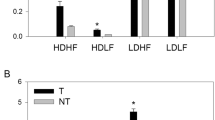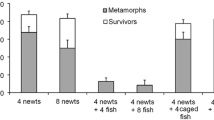Abstract
The effects to ecosystems by genetically modified organisms are still unknown, yet a transgenic version (the red glofish or red fluorescent protein (RFP) transgenic zebra danio) of the zebra danio, Danio rerio, a common aquarium fish, has become the first transgenic pet sold in the USA. It has been hypothesized that RFP zebra danios will not persist in nature because they will be preferentially preyed upon due to their red coloration; however, the bright coloration of wildtype zebra danios may indicate they are aposematic since they are not preyed upon immediately by predators in their native range. These hypotheses were addressed via nine predation experiments with largemouth bass, Micropterus salmoides, as predator and combinations of mosquitofish, Gambusia affinis, wildtype zebra danios, and RFP zebra danios as prey. Neither wildtype nor RFP transgenic zebra danios are aposematic since both varieties were readily consumed by largemouth bass in laboratory trials. Both varieties were preyed upon in approximately equal proportion (1.4 to 1.0) so the bright, apparently conspicuous coloration of the transgenic zebra danios did not increase their susceptibility to predation. In these laboratory trials, largemouth bass did not preferentially prey upon a native fish, the mosquitofish, relative to wildtype zebra danios (1.2 to 1.0). Based on the results of these experiments, wildtype zebra danios and RFP transgenic zebra danios are likely to be preyed upon in a similar fashion as native forage fish.
Similar content being viewed by others
References
Abrahams MV, Sutterlin A (1999) The foraging and antipredator behaviour of growth-enhanced transgenic Atlantic salmon. Anim Behav 58:933–942
Bams RA (1967) Differences in performance of naturally and artificially propagated sockeye salmon migrant fry, as measured with swimming and predation tests. J Fisheries Res Board Canada 24:1117–1153
Beitinger TL (1990) Behavioral reactions for the assessment of stress in fishes. J Great Lakes Res 16:495–528
Christensen B, Persson L (1993) Species-specific antipredatory behaviours: effects of prey choice in different habitats. Behav Ecol Sociobiol 32:1–9
Coble DW (1973) Influence of appearance of prey and satiation of predator on food selection by northern pike (Esox lucius). J Fisheries Res Board Canada 30:317–320
Cortemeglia C, Beitinger TL (In press) Projected U.S. distributions of transgenic and wildtype zebra danios, Danio rerio, based on temperature tolerance data. J Thermal Biol
Courtenay WR Jr (1993) Biological pollution through fish introductions. In: Knight BN (ed) Biological pollution: the control and impact of invasive exotic species. Proceedings of a symposium held at the University Place Conference Center, Indiana University-Purdue University at Indianapolis on October 25 & 26, 1991. Indiana Academy of Science, Indianapolis, Indiana, pp 35–61
Coutant CC (1973) Effect of thermal shock on vulnerability of juvenile salmonids to predation. J Fisheries Res Board Canada 30:965–973
Dill LM (1973) An avoidance learning submodel for a general predation model. Oecologia (Berl.) 13:291–312
Dill LM (1974a) The escape response of the zebra danio (Brachydanio rerio) I. The stimulus for escape. Anim Behav 22:711–722
Dill LM (1974b) The escape response of the zebra danio (Brachydanio rerio) II. The effect of experience. Anim Behav 22:723–730
Ginetz RM, Larkin PA (1973) Choice of colors of food items by rainbow trout (Salmo gairdneri). J Fisheries Res Board Canada 30:229–234
Gong Z, Wan H, Tay TL, Wang H, Chen M, Yan T (2003) Development of transgenic fish for ornamental and bioreactor by strong expression of fluorescent proteins in the skeletal muscle. Biochem Biophys Res Commun 308:58–63
Goodyear CP (1972) Simple technique for detecting effects of toxicants or other stresses on a predator–prey interaction. Trans Am Fisheries Soc 101:367–370
Hatfield CT, Anderson JM (1972) Effects of two insecticides on the vulnerability of Atlantic salmon (Salmo salar) parr to brook trout (Salvelinus fontinalis) predation. J Fisheries Res Board Canada 29:27–29
Heidinger RC (1976) Synopsis of biological data on the largemouth bass Micropterus salmoides (Lacèpede) (1802) FAO Fisheries Synopsis No. 115, Rome
Horth L (2004) Predation and the persistence of melanic male mosquitofish (Gambusia holbrooki). J Evol Biol 17:672–679
Howick GL, Oȁ9Brien WJ (1983) Piscivorous feeding behavior of largemouth bass: an experimental analysis. Trans Am Fisheries Soc 112:508–516
Johnson JE, Pardew MG, Lyttle MM (1993) Predator recognition and avoidance by larval razorback sucker and northern hog sucker. Trans Am Fisheries Soc 122:1139–1145
Kania HJ, Oȁ9Hara J (1974) Behavioral alterations in a simple predator–prey system due to sublethal exposure to mercury. Trans Am Fisheries Soc 103:134–136
Korpi NL, Wisenden BD (2001) Learned recognition of novel predator odour by zebra danios, Danio rerio, following time-shifted presentation of alarm cue and predator odour. Environ Biol Fishes 61:205–211
Knight GL, Gido KB (2005) Habitat use and susceptibility to predation of four prairie stream fishes: implications for conservation of the endangered Topeka shiner. Copeia 2005:38–47
Krause J (1993) Positioning behaviour in fish shoals: a cost-benefit analysis. J Fish Biol 43(Supplement A):309–314
Matthews M., Trevarrow B, Matthews J (2002) A virtual tour of the guide for zebrafish users. Resource 31:34–40
Menon AGK (1999) Checklist – Freshwater fishes of India. Hooghly Printing, Calcutta, India
Mesa MG, Poe TP, Gadomski DM, Petersen JH (1994) Are all prey created equal? A review and synthesis of differential predation on prey in substandard condition. J Fish Biol 45(Supplement A):81–96
Morgan MJ, Godin J-GJ (1985) Antipredator benefits of schooling behaviour in a cyprinodontid fish, the banded killifish (Fundulus diaphanous). Zietschrift für Tierpsychologie 70:236–246
Nam YK, Park I, Kim DS (2004) Triploid hybridization of fast-growing transgenic mud loach Misgurnus mizolepis male to cyprinid loach Misgurnus anguillicaudatus female: the first performance study on growth and reproduction of transgenic polyploid hybrid fish. Aquaculture 231:559–572
Nyberg DW (1971) Prey capture in the largemouth bass. Am Midland Nat 86:128–144
Pitcher T (1992) Who dares, wins: the function and evolution of predator inspection behaviour in shoaling fish. Netherlands J Zool 42:371–391
Protosov VR (1970) Vision and near orientation of fish. Israel Program for Scientific Translations, Jerusalem
Reddy SR, Kote G (1975) Predatory behavior of Gambusia affinis in relation to different light colors. Physiol Behav 14:255–257
Reynolds WW, Casterlin ME (1976) Activity rhythms and light intensity preferences of Micropterus salmoides and M. dolomieui. Trans Am Fisheries Soc 105:400–403
Robbins WH, MacCrimmon HR (1974) The blackbass in America and overseas. Biomanagement and Research Enterprise, Sault Ste. Marie, Ontario
Rowland WJ (1999) Studying visual cues in fish behavior: a review of ethological techniques. Environ Biol Fishes 56:285–305
Sass GG, Motta PJ (2002) The effects of satiation on strike mode and prey capture kinematics in the largemouth bass, Micropterus salmoides. Environ Biol Fishes 65:441–454
Savino JF, Stein RA (1982) Predator–prey interaction between largemouth bass and bluegills as influenced by simulated-submersed vegetation. Trans Am Fisheries Soc 111:255–266
Scherer E, McNicol RE, Evans RE (1997) Impairment of lake trout foraging by chronic exposure to cadmium: a black-box experiment. Aquat Toxicol 37:1–7
Schneider MJ, Barraclough SA, Genoway RG, Wolford ML (1980) Effects of phenol on predation of juvenile rainbow trout Salmo gairdneri. Environ Pollut (Series A) 23:121–130
Schramm HL Jr, Zale AV (1985) Effects of cover and prey size on preferences of juvenile largemouth bass for blue tilapias and bluegills in tanks. Trans Am Fisheries Soc 114:725–731
Sullivan JF, Atchison GJ, Kolar DJ, McIntosh AW (1978) Changes in the predator–prey behavior of fathead minnows (Pimephales promelas) and largemouth bass (Micropterus salmoides) caused by cadmium. J Fisheries Res Board Canada 35:446–451
Talwar PK, Jhingran AG (1992) Inland fishes of India and adjacent countries. vol 1. A. A. Balkema, Rotterdam, The Netherlands
Theodorakis CW (1989) Size segregation and the effects of oddity on predation risk in minnow schools. Anim Behav 38:496–502
Webb PW (1986) Effect of body form and response threshold on the vulnerability of four species of teleost prey attacked by largemouth bass (Micropterus salmoides). Can J Fisheries Aquat Sci 43:763–771
Webber HM, Haines TA (2003) Mercury effects on predator avoidance behavior of a forage fish, golden shiner (Notemigonus crysoleucas). Environ Toxicol Chem 22:1556–1561
Woltering DM, Hedtke JL, Weber LJ (1978) Predator–prey interactions of fishes under the influence of ammonia. Trans Am Fisheries Soc 107:500–504
Zar JH (1999) Biostatistical analysis. 4th edn. Prentice-Hall, Inc., Upper Saddle River, New Jersey
Acknowledgements
We wish to thank the Texas Parks and Wildlife Department (Rafe Brock, Ken Bickel, Tom Hungerford, and Andy Wallace) for providing the bass and Sean Crawford of Dallas North Aquarium for assistance in obtaining the glofish. We also thank Dr. Robert C. Benjamin, T. Adam Cochran, John Coffman, Becky DeWaters, Steve Timmons, Charles Pittman, and Cynthia Thomas for help in the laboratory or field.
Author information
Authors and Affiliations
Corresponding author
Rights and permissions
About this article
Cite this article
Cortemeglia, C., Beitinger, T.L. Susceptibility of Transgenic and Wildtype Zebra Danios, Danio rerio, to Predation. Environ Biol Fish 76, 93–100 (2006). https://doi.org/10.1007/s10641-006-9011-x
Received:
Accepted:
Published:
Issue Date:
DOI: https://doi.org/10.1007/s10641-006-9011-x




